Today is Halloween in America, and you can be sure as hellfire that I'm writing about some spooky stuff today. That spooky stuff will be the creepiest, scariest, and most unsettling pieces of artwork in all of Magic: The Gathering.
Magic has courted horror many times in its 25-year history. From the mechanized monsters of Phyrexia to demonic blood rituals, from eldritch mutations to the most sadistic humans ever to draw breath, this game has tried to scare its audience more than most fantasy properties. It's not just grossing out the audience, either. Horror is built on suspense, anxiety, psychological fears, and visuals that linger in your memory.
A top ten is too pedestrian for Halloween, so I'll be counting down the top thirteen scariest pieces of Magic art instead. If you have a weak stomach, you may want to stop reading now. Even if you think you can handle some seriously disturbing art, I'd still recommend reading this article with the lights on.
Good luck, fellow planeswalkers.
#13: Nest of Scarabs
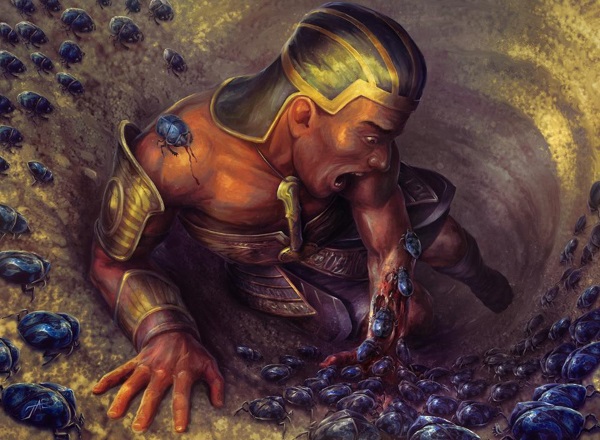
Art by Jason A. Engle
Bugs instill a primal fear in humans. Mosquitos and fleas transmit infectious diseases. Cockroaches eat our food. Locusts destroy our crops. Spiders and scorpions inject us with deadly venom. Flies lay eggs under our skin. Our social evolution has conditioned us to hate bugs for millennia.
A swarm of bugs is scary enough, but Nest of Scarabs pushes the horror of such a situation to fatal limits. While it's difficult to see at card size, this initiate's left arm is being rapidly consumed by scarab beetles. Trapped in their sandy nest, he has no choice but to watch as his skin and muscle are stripped away.
We'll save the "is gore actually scary?" argument for another day, but it's important to take note of the role that gore plays in horror. The genre is rooted in anticipation. The unknown that is just around the corner, hidden by shadows, just a few seconds in the future is the bread-and-butter of horror. In this piece, the gore builds a sense of anticipation. Our minds are free to visualize what happens next: every inch of flesh is scoured from this human's bones.
#12: Phyrexian Rager
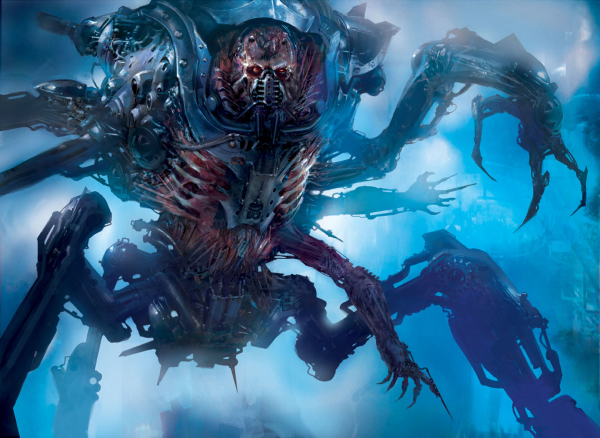
Art by Stephan Martiniere
Few subgenres of horror are so visceral as body horror. The reconfiguration of a body's shape and form through artificial or biological means is both physically unsettling and psychologically disturbing. From the depths of the uncanny valley to the heights of monstrosity, body horror is something that Magic has decades of experience with.
There is no villainous faction in Magic as iconic as the Phyrexians, who consider organic life weak and impure. To the Phyrexians, your skin, bones, muscle, and sinew are simply raw materials that can be used or discarded at will as your body is rebuilt with mechanical superiority. The scariest Phyrexians still bear echoes of their past humanity.
Phyrexian Rager is the best example of Phyrexian body horror. It's mostly a machine that would simply be a cool monster. And then you notice the red splatter around the head. The bony remains of a skull riveted to steel. And the chest. Oh lordy the chest, complete with a set of human ribs and chunks of viscera and connective tissues keeping this monster together. That this monster obviously used to be human is the core of the psychological horror of Phyrexia.
#11: Brain Maggot
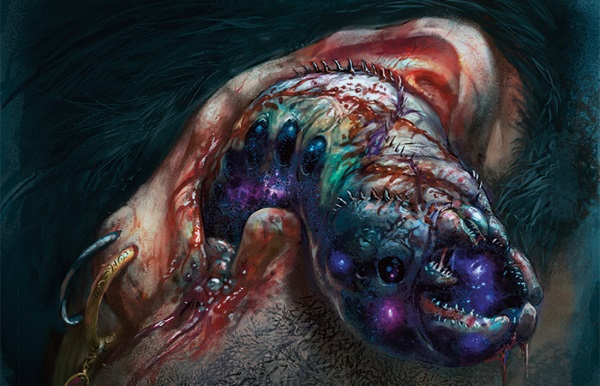
Art by Dave Kendall
Much of what was said about Nest of Scarabs is true about the Friday Night Magic promo version of Brain Maggot. While still arthropods, maggots are larval flies that are superficially more like worms. This piece gives a much more intimate look at gore, featuring a bloody and pus-filled aural cavity. The cavity where a god-cursed insect has been gorging itself on your brain and is now wriggling out your skull. Can you feel it in there? The pressure as it tears your tissues open in escape? The brain has no pain receptors, but your ears very certainly do.
Adding to the horror of this piece is the very real medical condition of myiasis. Earlier mention of flies laying eggs in human skin wasn't mere melodrama. Various flies known colloquially as bot flies or blowflies lay eggs in all sorts of mammalian hosts. While this is usually a problem for livestock, humans occasionally become hosts for developing maggots. Open wounds and body cavities are the most common sites of myiasis, although infections are rarely fatal. This doesn't stop myiasis from being disgusting in both real life and fantasy.
#10: Vedalken Anatomist
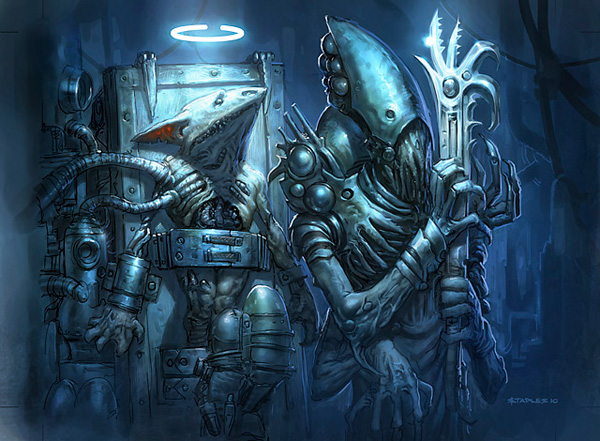
Art by Greg Staples
Unwanted and intrusive medical procedures are another real-world fear that Magic capitalizes on. The Phyrexians themselves are scary, but their actions also heighten the horror of their civilization.
Phyrexians are obsessed with the physical, unable to comprehend the mind or spirit. Their disdain for flesh makes them exceptionally uncaring about things like ethics and consent, especially in the blue-aligned faction on New Phyrexia. Thus, the emotional focus of Vedalken Anatomist isn't the scientist, but the traumatized goblin being vivisected.
This piece showcases the violating horror of experimentation on live, sapient subjects. That we're meant to connect with the victim in the piece helps us imagine that it's our arm that has been mechanized, our stomach that has been left gaping, and our face that contorts as we are powerless to stop this unsympathetic Phyrexian from deconstructing our body. A little gore helps make this a truly psychologically frightening piece.
#9: Transgress the Mind
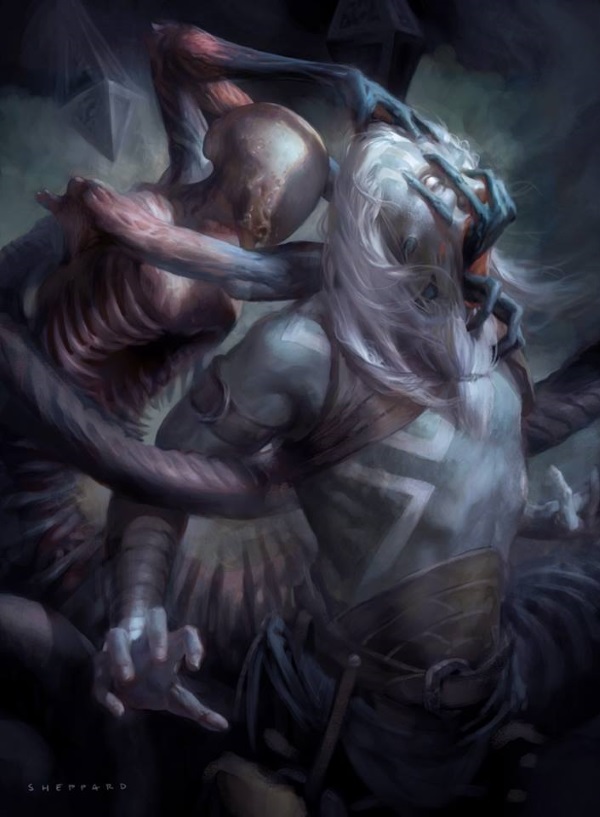
Art by Cynthia Sheppard
The unfathomable Eldrazi are built from the works of H. P. Lovecraft and August Derlith. This subgenre posits that human intentions are largely irrelevant to the greater workings of the cosmos, and beings that can't even be bothered to regard us are going to upend our lives. The fear of the unknown, and not understanding why bad things happen, drive cosmic horror.
Thankfully, Transgress the Mind is plenty scary with its visuals alone. Sure, we don't know what the hell this Eldrazi is doing or why, and the card name carries the same invasive feel as Vedalken Anatomist, but "creature hands ripping your head open from the inside out" is its own level of unsettling.
There's a lot of great monster stuff going on here. Three of the Eldrazi's four hands are exploring this kor's skull, which is an unsettling departure from an otherwise humanoid form. There's a notable lack of gore here. We see fingers poking through the kor's skin and his jaw stretching, but otherwise this is clean violence. This subverts expectations, heightening the creep factor. The cosmic horror part is visually represented by this act, as we have no idea how the physics of this attack even work. Are the Eldrazi's arms intangible, but still able to claw through flesh? It's disturbing on multiple axes.
#8: Macabre Waltz
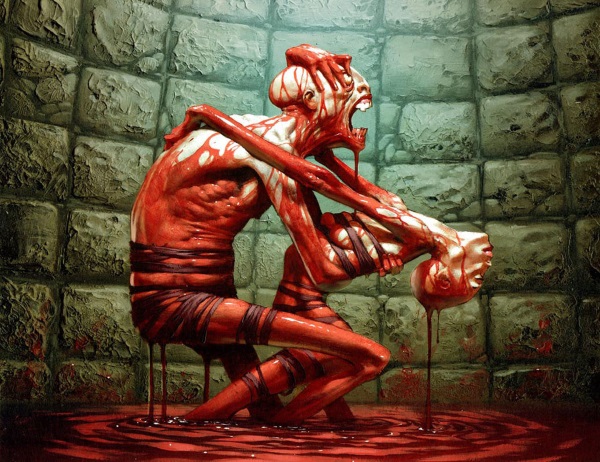
Art by Jim Murray
The real horror of Macabre Waltz isn't the copious amounts of blood. Rather, the creepiest aspect of this image lies in the uncanny valley. You might be able to see where I'm going with this. Look at the two figures here. The flattened and elongated craniums. The spindly appendages. The monochromatic skin. These figures are almost human in appearance, but the exaggerated style makes them frighteningly uncanny. The dance pose is mocking the humanity that they so narrowly avoid. It's unsettlingly playful, which is how the gallons of blood accentuate the tone of the piece. Being able to walk that line between cheeky and creepy is the success of this illustration.
#7: Appetite for Brains
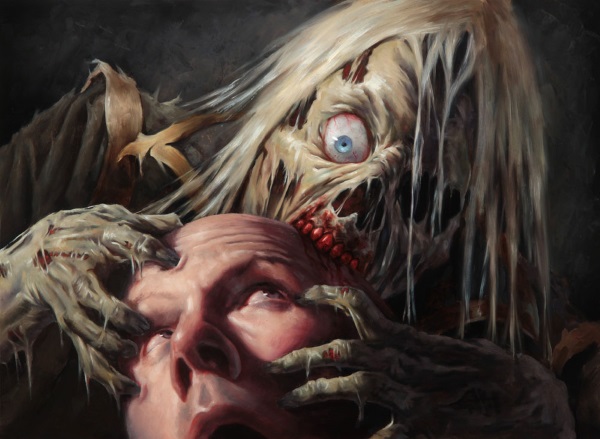
Art by Michael C. Hayes
People are afraid of dying. Art showing someone getting eaten by zombies? Great way to scare people. While Appetite for Brains isn't the only Magic card to depict a human becoming lunch, it's by far the most intimate. The fact that it's a single zombie killing a single person, and not a horde versus a mob, heightens the tension and fear.
Fear, by the way, is written all over the victim's face. They can't even really see what's happening to them, which makes their situation even more frightening to be in. And this scary situation is full of details that make it even scarier. The zombie's fingers are digging into the victim's skin. It's a tight grip showcasing the strength of the monster and the futility of escape. You're getting eaten, period. But also look at the blood on the zombie's teeth. There are trickles running down the skull, but this ghoul looks like it's fed before. Has it already eaten the other side of your brain? Did it just eat your spouse? If you're not its first victim, how many more will it consume after you're dead? This is a piece that poses such storytelling questions to get you to imagine whatever scenario is scariest to you.
#6: Witch-Maw Nephilim
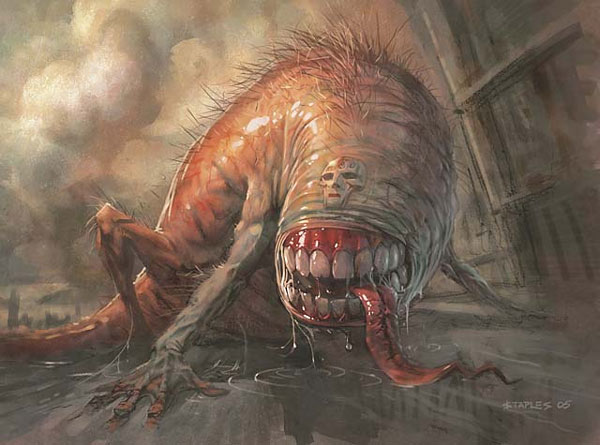
Art by Greg Staples
It's hard to make scary monsters. The xenomorphs are much scarier when they're a background tail flick and orthodontic closeup in Alien than when there are a bunch of them out in the open in Aliens. Creature features have long relied on slow disclosure to build suspense. Show too many of them, and it's game over, man. Game over.
Witch-Maw Nephilim belongs to the more abstract variety of body horror, which thrives on the visuals of physical beings. It's no surprise that many of Magic's scariest monsters fall into this subgenre.
This Ravnican ancient is built from body parts that are connected in ways that they shouldn't be. To be blunt: a wrinkled flesh-tube makes it look like a mutated member with a mouthful of incisors, a lengthy tongue, and veiny arms with too-human hands. Details like the glistening saliva and sparse hair enhance the realism and make it feel like the creepy flesh-monster that it is. This is a critter that goes beyond gross and enters a horrific realm of anatomical amalgamations.
#5: Slaughter Games
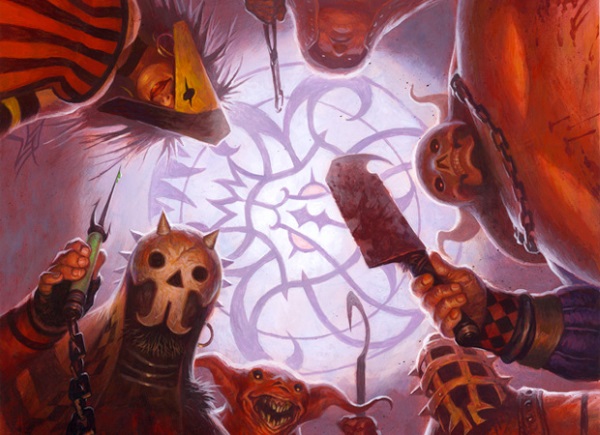
Art by Steve Prescott
A lot of good horror art puts you in the shoes of the victims. Slaughter Games literally does this by being painted in the victim's point of view. It's a technique that pays big dividends when used properly, and this is a great example of its success.
What are the emotional themes of this card? First is the anticipation of violence. "Slaughter" is right in the title, and we're surrounded by individuals with all kinds of pointy objects. Needles, hooks, and a bloody cleaver are raised and waiting to be embedded into our body. The flatness of the illustration even helps hair and clothing look spiky and dangerous. Showing the moment before this all happens forces us to imagine it actually happening. Each individual viewer is free to imagine each step in the process of their own dismemberment, injecting their own individual fears into the process.
The second theme is one we've seen a few times already: helplessness. Having the point of view from the ground lets the Rakdos cultists form a barrier between our field of vision and freedom. Even worse, the center of the image features a pattern of a demon's face, mocking us. No escape there either. In all of Magic, this is the best piece that implies the gore and trauma in a way that plays into the psychology of suspense.
#4: Brisela, Voice of Nightmares

Art by Clint Cearley
Brisela, Voice of Nightmares is a piece of art that never tires the viewer. It's the epitome of body horror in Magic, manipulating anatomy in unholy ways that subvert our notions of what bodies should look like. And lordy is there a lot going on in this piece. Let's start with the obvious: two sapient lifeforms are being melded together into one monster that is neither previous individual. Humans cherish their sense of self, so taking that away, creating ego death while the body suffers all the mockery of nature that creatures from the beyond are capable of inflicting, plays into psychological horror. Bruna and Gisela cease to exist; there is only Brisela, the extension of Emrakul.
From there, it's easier to just list the creepy stuff going on in this art:
- Brisela's heads aren't just next to each other, they're joined at the sides by drooping flesh.
- What used to be Bruna's head is missing a lower jaw, but has a second upper jaw to make up for it.
- Hair has been replaced by tentacles more reminiscent of intestines that follicles.
- The sisters' four "normal" arms are ripping open her torso to spill out viscera of more magenta tentacles. It's the illusion of gore without being gore, subverting even horror itself.
- Two huge arms, bifurcated and latticed in Emrakul's style, end in multiple hands. But not angel hands. Hook-fingered monster hands.
- Stalks growing from behind Brisela's heads are proto-arms with proto-fingers, adding another layer to the echo of wings.
- One set of wings is largely intact, but the other is more faux gore of bone and sinew. The bone isn't structured in a way that a normal wing would be. It's the right material, but the wrong shape. The juxtaposition with the feathered wings highlights the grotesque pair.
- Instead of legs, she has thick tentacles made from sinew and spinal columns. That's not even what legs are supposed to be made out of. Repurposing body parts for different functions is a common trope in body horror.
Brisela is hard to look at. It's almost impossible to tell where the humanoid parts end and the monster parts begin. The simulated gore, warping of anatomy, and classic corruption narrative let this piece horrify from multiple angles at once.
#3: Sensory Deprivation

Art by Steven Belledin
All the little details really bring together this piece. Sensory Deprivation is a card entirely made up of details instead of in-your-face viscera or monstrosity. We're looking at an extreme closeup of a face. We don't know whose face. Their eyelids and lips have been sutured, but, torturously, not all the way closed.
There is nothing magical about this piece. It's not a monster. It's not fantastical. It's simply a face with some coarse thread woven into it. The realism here is the foundation of the creepiness. Outside the context of the multiverse, this could be a painting of a real-life incident, and it's certainly tamer than what you can find at some crime scenes.
It's the details that sell the visceral horror here. Look at all the little creases where the thread is pulling on the skin. A short stitch on this person's left eye is tugging more than the others. The upper lip is crimped where the thread digs into the skin, while the bottom lip is scalloped where it pulls the loose flesh up.
And then there's the bottom corner of the mouth, where the thread trails out of the frame. It's not magical thread. It's agonizing needlework. Puncture wounds on a still-living face. You can probably feel it now. The tugging. The stretching and release as your skin gives way to the needle's point. The thread scratching your tissue as it's pulled through your flesh. Knowing that it's not a monster doing this to you, but another person.
This fate could actually happen to you.
If you're not careful.
#2: Fleshformer
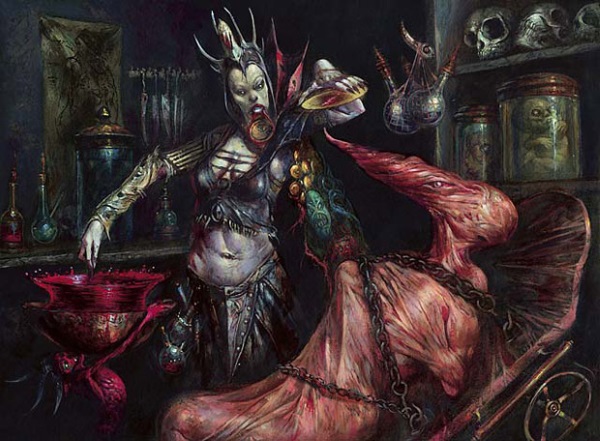
Art by Dave Kendall
It's been a while since we've seen graphic, grotesque art in this article. Lucky for us, Fleshformer is all about that. It makes sense for Grixis, a world where even the ground has eyes and teeth.
This piece is the confluence of many types of visual horror we've looked at today. We have a forced surgical scenario with a body horror victim that features plenty of blood. This necromancer is using some sort of blood funnel and golden disc as tools to shape generic flesh into horrific forms. It's difficult to say if she started with a body and warped it or if she started with a bloody mass of meat and is shaping it into a body. We clearly see an eye on the twisted face, the shoulder and upper arm on the side facing us, and a knee and thigh below. This is body horror taken to the extreme, where all parts of a figure are indistinguishable from each other as a slab of unified flesh. The creepiness of the victim's body is self-evident.
And then we look at the background shelves. Jars hold previous experiments that evoke twisted fetal forms. Misshapen skulls sit on the shelf above, eye sockets warped in size and location. How many more "experiments" lie just out of the frame? Is there a room with fleshy "raw material" waiting to be sculpted? What shapes will she mold your flesh into when it's your turn?
#1: Phyrexian Unlife
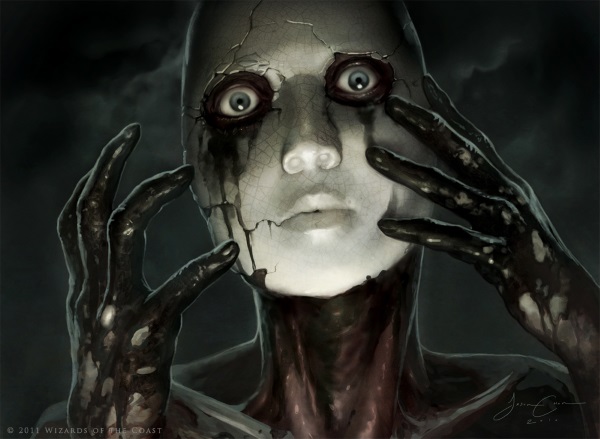
Art by Jason Chan
This is it: the creepiest, scariest, most unsettling piece of art in Magic. If Brisela is the epitome of body horror, then Phyrexian Unlife is the epitome of the uncanny valley. Here we have an unwilling acolyte of the Machine Orthodoxy, metal mask already fused to their face. The static, cracked, porcelain-like face is a manikin nightmare. It's the face of literal objectification, a loss of animation that annihilates humanity, identity, and emotion.
Oh, but what emotion in this piece! We know those eyes. We know those hands. This is pure distress, fear, and sorrow. We empathize with the subject's feelings. "What has happened to me?" But "me" has almost totally lost its meaning. Humans identify with faces easily, but that's what is now Phyrexian.
This is a painting without hope. It's too late. They're as good as gone. Their hands are covered in "blood," the glistening oil of contagion. They smear it on their face. It mixes with their "tears," which are now simply more glistening oil. They cannot escape Phyrexia's grasp on their body. They will not be saved. They're no longer your mother, or your brother, or your child. An uncanny simulacrum of a person is all that remains.
The horror of Phyrexia is the regression of humanity, individuality, emotion, and agency to nothingness. Showing this horror using the uncanny ensures a creepy result. Blending the human and the inhuman walks the line that Phyrexian aesthetics occupy. They are a mockery of biological life, making the uncanny a perfect vector for their alien nature.
Checking Out of Spook Central
Congratulations! If you're reading this, you successfully made it through an article rife with terror. Magic goes back to the horror well every so often, but it's played around with so many subgenres and tropes within that aesthetic. Gory body horror, unsolicited surgery, and cannibalistic glee are just a handful of situations that artists have used to try to scare players around the world.
Hopefully we found at least one piece of art that creeps you out today. It was interesting to follow some of the trends that kept appearing in scary Magic art and identifying what made them terrifying to begin with. Overall, the game has had its most success creeping people out when art has focused on the physicality of horror. The best scary cards marry art with names and flavor text to create micro horror stories that leave your imagination to fill in the rest of the nightmarish details.
Good night, planeswalkers, sleep tight, and don't let the scarab beetles bite.
-
View User Profile
-
Send Message
Posted Nov 6, 2017Spined Fluke
-
View User Profile
-
Send Message
Posted Nov 4, 2017Maze of Ith
Ad Nauseam
Mind Twist
Sanity Gnawers
-
View User Profile
-
Send Message
Posted Nov 1, 2017-
View User Profile
-
Send Message
Posted Nov 1, 2017-
View User Profile
-
Send Message
Posted Nov 1, 2017Its fun to see someone else's list. This is always subjective as I suspect each reader would have a different list.
-
View User Profile
-
Send Message
Posted Nov 1, 2017-
View User Profile
-
Send Message
Posted Nov 1, 2017I always thought Terror was scary just by imagining what the guy in the picture is looking at before his death...
I miss how art used to look in the 90s, cards like Diabolic Vision, Touch of Death, Brood of Cockroaches, Derelor..
-
View User Profile
-
Send Message
Posted Nov 1, 2017Actually, Ice Age was pretty terrifying:
Oh, and Takklemaggot?
-
View User Profile
-
Send Message
Posted Oct 31, 2017-
View User Profile
-
Send Message
Posted Oct 31, 2017I like many of the arts chosen, but I think the flavortext is a crucial piece that can magnify horror.
Bonus: Favorite Rakdos horror is Showstopper.
-
View User Profile
-
Send Message
Posted Oct 31, 2017You can see the pain on their faces from how horribly it must hurt to have your body be warped and fused with another's
whenever I look at this card I will always hear her distorted roar echoing across Innistrad
-
View User Profile
-
Send Message
Posted Oct 31, 2017Just a bit surprised in seeing nothing of the old era of magic, hehe. Is this supposed to be '13 scariest cards legal in modern?'
I always thought of The Fallen as particularly terrifying.
Also completely shocked in how Field Creeper didn't get a spot in the halloween article. Art is amazingly dark and on-tone.
-
View User Profile
-
Send Message
Posted Oct 31, 2017I read somewhere that even the artist found it scary.
Anyway, I'll agree with these picks, but some have been left out, like Living Wall, Grave Pact and Buried Alive
-
View User Profile
-
Send Message
Posted Oct 31, 2017There has only been one card that jump-scared me when I opened a pack of cards: Rotting Fensnake. I made it my laptop background for class so if I jump straight to the desktop I can hear the reactions of the people that were looking at my screen.
-
View User Profile
-
Send Message
Posted Oct 31, 2017-
View User Profile
-
Send Message
Posted Oct 31, 2017-
View User Profile
-
Send Message
Posted Oct 31, 2017